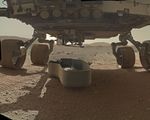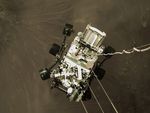Lori S. Glaze, Ph.D. NASA Planetary Science Division Director - CAPS March 24, 2021
←
→
Page content transcription
If your browser does not render page correctly, please read the page content below
FY21 Appropriations Highlights
• FY 2021 Consolidated Appropriations Act signed into law December 27, 2020
• Continued strong support for Science with a $7.3B budget
• $994M above the FY21 President’s Budget request
• $162M above the FY20 enacted level
Planetary Science
• $40M above the FY21 request
• Funding to support decadal priorities such a Mars Sample Return mission,
Europa Clipper
• Additional funds for Planetary Defense, supporting DART and Near-Earth
Object Surveillance Mission
• Additional funding for New Frontiers/Dragonfly
• Strong support for Lunar Discovery and Exploration, as well as Commercial
Lunar Payload Services
• Europa Clipper given permission to use CLV in the event SLS is not available
or incompatible
($M) FY14 FY15 FY16 FY17 FY18 FY19 FY20 FY21
Omnibus Bill
PSD 1,342.3 1,446.7 1,628.0 1,827.5 2,217.9 2,746.7 2,712.6 2,700.0
3Social and Traditional Media Coverage
Landing Broadcast:
• 4.2 million (at peak) live viewers watching the event broadcast of the Perseverance landing
• YouTube video of coverage: 21 million views (as of March 25) and top viewed video of all time on the NASA
YouTube channel
Landing video viewership:
• Landing YouTube video maintained #2 trending spot on YouTube
• 14 million video views (as of March 15)
Web Traffic: 26.9 million page views across all NASA sites on landing date (triple traffic from launch)
Hashtag Performance: >248k total social media mentions involving #CountdownToMars/Mars2020/Perseverance
(Feb 18 to 19 across platforms)
Notable Mentions: From POTUS, VPOTUS, FLOTUS, Barack Obama, Ringo Starr
Traditional media:
• >8.7k media mentions between Feb 18 and 19 (e.g., The New York Times, CNN, NPR)
• Front pages of 157 newspapers
• About 200 interviews with NASA experts; 25 in Spanish; 28 as radio/podcast format (most ever for both)
8Ingenuity • Will be a 30-Mars-day experimental flight test window once helicopter is deployed to the surface • Will be first flight of an aircraft on another world • If Ingenuity succeeds in taking off and hovering during the first flight, it will have achieved >90% of the project’s goals • If Ingenuity lands successfully and remains operable, up to four more flights could be attempted
“Van Zyl
Overlook”
Rover
Observing
Location
Helicopter Debris
Drop Off Shield
Drop Off
Rover
Landing
Site
~65m
Rover
Landing Site ~85m
~100m
Possible
Approximate Ingenuity and Rover
Perseverance Locations observation
locationsMars Sample Return
13Current Status
• Mars Sample Return (MSR) approved to proceed to Phase A in
December
• Because of size, complexity, and technological and engineering
advances required, several processes were initiated Pre-Phase A:
• Two independent cost/schedule estimates
• Independent Review Board (IRB) program examination
• Standing Review Board established to conduct MCR as an Agency
review
• Relationship between MSR and Mars Exploration Program (MEP) is
being finalized in a Memorandum of Agreement
• PSD Lead Mars Scientist (Michael Meyer) will serve as both MEP
Lead Scientist and MSR Program Scientist
• Joint Steering Group (JSG), co-chaired by MEP (Eric Ianson) and
MSR (Jeff Gramling) Program Directors, will be used to resolve any
issues; will be convened on an as-needed basis
• MEP Director will serve as a member of the MSR NASA/ESA Joint
Steering Board and will present MEP recommendation at MSR
decisional meetings
• MSR and MEP Program Offices are both at JPLMars Sample Return Architectural Overview Mars Sample Return Campaign Concept Review
Mars
Mars 2020 Tube Delivery
SRL
Mars
Ascent
Vehicle
Tube Retrieval Sample Fetch
Tube Collection & Depot Rover
Orbiting
Sample
Retrieve OS
Relay Support
ERO Break-the-Chain
Avoid Earth
Earth Entry
Vehicle
Earth
Mars2020 Earth Return Orbiter Sample Retrieval Lander Sample Return and Science
15MSR Campaign
Mars Sample Return Program
1 2 3 4
Sample Caching Rover Sample Retrieval Lander Earth Return Orbiter Mars Returned Sample
(Mars 2020) Operations Handling
•Fetch Rover •Capture/Containment
•Sample System •Sample Receiving Facility
•Orbiting Sample (OS)
acquisition/caching Container •Earth Return Vehicle •Curation
•Sample (subset) delivery •Mars Ascent Vehicle •Sample science
investigations
Initiates the Campaign New Element New Element New Element
Ground Element
To be reviewed at a future
date
16Mars Returned Sample Science
• Perseverance is capable of selecting and caching 43 samples
• 15 NASA/ESA Returned Sample Scientists have been competitively selected for the
Perseverance Science Team
• Caching Strategy Workshop held January 2021
• Recommended modifications to the Operations MOU between Perseverance and SRL
• NASA/ESA Mars Sample Return Science Planning Group – Phase 2 (MSPG2)
• Meeting weekly to:
• Develop a Science Management Plan
• Address science technical issues
• Propose a working list of high-level requirements for the Sample Return Facility
• Develop a timeline of key decision points
• Report expected Spring 2021
• A JPL and JSC team visited 18 BioSafety Level-4 and contamination-controlled facilities to
scope the containment challenges of conducting science with returned Mars samples
• Report available: http://hdl.handle.net/2014/50446
• COSPAR Sample Safety Assessment Protocol Working Group (SSAP), with NASA and ESA
members, is developing a recommendation for determining when extraterrestrial samples are
safe for distribution outside of containment – progress reported at COSPAR Assembly 2021Coming Up In 2021
18OSIRIS-REx • Final flyby of Bennu:
April 7, 2021
Touch-and-Go (‘TAG’) • Will image sample
at Nightingale Crater
Oct 20
collection site, Nightingale,
to look for surface
transformations (mimicking
a 2019 observation
sequence)
• Will image Bennu for a full
4.3-hr rotation to obtain
high-resolution images of
the northern and southern
hemisphere and its
equatorial region
• Headed back to Earth:
May 10, 2021
• Arrives Earth:
September 2023
19Lucy
• First mission to the Trojan asteroids:
• 12 years, 7 flybys, one spacecraft
• ATLO progressing well
• Pre-Environmental Review completed –
modal survey testing has begun in
Reverberant Acoustic Lab
• All spacecraft components, including
solar arrays and high-gain antenna,
and blanket now installed
• Launch and Asteroid Encounter
Systems Verification Tests performed
successfully
• Due to ship to Cape Canaveral late July
• Launch window opens October 2021; first
Trojan flyby August 2027
20Double Asteroid Redirection Test
• Risk assessment was performed on DART project schedule to
determine viability of primary and secondary launch periods
• Technical challenges associated with DRACO imager and
solar arrays
• SMD has directed DART project to pursue secondary
launch window (November 24, 2021 to February 15, 2022)
• Project is working with SpaceX and NASA’s Launch
Services Program to identify earliest possible launch
opportunity within this window
• DART will arrive at Didymos binary asteroid system within
a few days of the originally scheduled impact date
(September 30, 2022)
• Integration and Test activities are ongoing
• LICIACube manufacturing, integration, and test has started; on
track for delivery May 2021ESCAPADE
Escape, Plasma and Acceleration
Dynamics Explorers
SIMPLEx
SIMPLEx-1
Q-PACE:
• Launched on Virgin Orbit’s LauncherOne January 17
• As of March 23, the spacecraft’s beacon has not
been detected despite multiple attempts
LunaH-Map:
• Will launch on Artemis-1, NLT November 2021
• Delivery required March 2021
SIMPLEx-2
Janus (Psyche rideshare):
• Passed KDP-C in September; CDR held February
Lunar Trailblazer (IMAP rideshare):
• Passed KDP-C in November; CDR will be in June
EscaPADE (TBD rideshare):
• KDP-C will be summer 2021
22Juno and InSight
• Extended missions for both missions
approved!
• Juno: approved through September 2025
• Continued investigation of Jupiter
• Flybys of Ganymede, Europa, Io
• Investigation of Jupiter’s rings
• Planning to run a Participating
Scientist Program in ROSES-2021
• InSight: extended for two years (through
December 2022)
• Focus on producing long-duration, high-quality seismic dataset
• Continued operation of weather station and burial of seismic
tether using Instrument Deployment Arm
• ‘Mole’ recovery efforts have now ended
• Energy challenges caused by dust covering the solar arrays
23VIPER
• Golf-cart-sized rover – first ever resource
mapping on another body
• Will be delivered by Astrobotic (CLPS) late
2023 for a 100-day mission
• Will explore the South Pole of the Moon in
search of water ice and other potential
resources
• Instruments: neutron, near-IR, and mass
spectrometers; and a 1-m drill
• KDP-C held February 23, 2021Europa Clipper
Project Schedule: Project & Flight System CDR was
December 2020; in midst of reporting results to HQ
Launch: Team is working to launch readiness in 2024; in
process of acquiring CLV via competitive selection – RFP
has been released
Instrument Cost Control: EIS and MASPEX are
proceeding well under their cost caps
Instrument & Flight System Hardware: Instruments
are delivered this year!
Concerns: COVID impacts are stretching resources,
thermal pump, internal electrostatic discharge (IESD),
EM interference/cleanliness, contamination control
Clockwise, starting top left: REM installation
to lower cylinder of Propulsion Module;
NADIR deck shock testing of NAC and WAC;
FM oxidizer tank; EM flux gate sensor
25Looking Forward
26Discovery and New
Frontiers
Discovery
• Discovery 2019 remains on schedule,
despite COVID-19
• Aiming for Step-2 selections June 2021
New Frontiers
• Dragonfly progressing toward confirmation
• NF5 to be released Fall 2022 (current
schedule)
• Community engagement began last fall
and is ongoing
• Community announcement with
planning parameters released
November 5
• Community Town Hall will be held late
March
27Astrobiology
Astrobiology Updates
PSD Research & Analysis Programs
• Exobiology: 23/156 proposals selected in ROSES-20
• Habitable Worlds:
• ROSES-20: 71 Step-2 proposals received
• ROSES-21: Not solicited
• PSTAR: now on a biennial solicitation (solicited in ROSES-2021)
• Interdisciplinary Consortia for Astrobiology Research (ICAR):
• 8 Teams selected; awards made in February 2021 (average size
$5M)
• Will be solicited on a three-year cadence
Conferences:
• Habitable Worlds Conference held February 2021, cohosted by
NExSS, AAS, and NExSci
• Astrobiology Graduate Conference (AbGradCon): Scheduled for
September 14–17 in TokyoCommunity
30Community Initiatives –
NASEM Studies
• Decadal Survey panel meetings are ongoing
• Additional mission concept studies list received, and started
• Targeting release March 2022
• NASEM study on Increasing Diversity and Inclusion in the
Leadership of Competed Space Missions:
• Jointly performed under Space Studies Board and Board on
Science Education
• Committee co-chaired by Fran Bagenal (LASP) and Wanda
Ward (UIUC)
• NASA has requested a study from the NASEM Committee on
Planetary Protection on the criteria for determining locations on
Mars that are suitable for robotic missions of lower biological
cleanliness than the current Category IV requirements – study will
likely be complete by Fall 2021Community Opportunities
• As part of a PSD pilot study Psyche, Europa Clipper, and
Dragonfly provided the opportunity for early-career scientists
to observe their science team meetings
• Lessons learned being considered before continuing the
program
• Next PI Launchpad: June 14–25, 2021
• Virtual over two weeks: 1 week of asynchronous content, 1
week interactive (2 to 3 hours per day)
• Application information posted to NSPIRES January 28;
deadline for applications: March 22; notifications by May 3
• Content from 2019 workshop is online:
https://science.nasa.gov/researchers/pi-launchpad
• Senior review of the Planetary Data System discipline nodes will begin with a call for proposals from the existing
nodes in March 2021; will be influenced by the Planetary Data Ecosystem Independent Review Board findings
and recommendationsR&A Updates
• COVID-19 Augmentations and Funded Extensions
• Several requests were not eligible, mainly because of large uncosted numbers
• Eligible, high-priority requests have been approved
• Additional requests (received by deadline) are being evaluated
• Habitable Worlds (ROSES-20) Dual-Anonymous Peer Review (DAPR) proposals have been
submitted and review process has started:
• Several proposals returned without review because of egregious DAPR rule violations
• Many other non-compliances observed; PIs will be ‘warned’ this year
• ROSES-2021 was released February 12
• All PSD data analysis programs (CDAP, DDAP, LDAP, MDAP, NFDAP) and cross-divisional
Exoplanet’s Research Program (XRP) will use DAPR
• No Due Date (NoDD)/Rolling Submissions in place for seven PSD programs:
• Solar Systems Workings, Emerging Worlds, Exobiology, PICASSO, Laboratory Analysis
of Returned Samples, Solar System Observations, PDART
• No proposal can be submitted to any NoDD program if it was previously submitted within
the past 12 months
• More information: https://science.nasa.gov/researchers/NoDD
33with us
34You can also read



























































